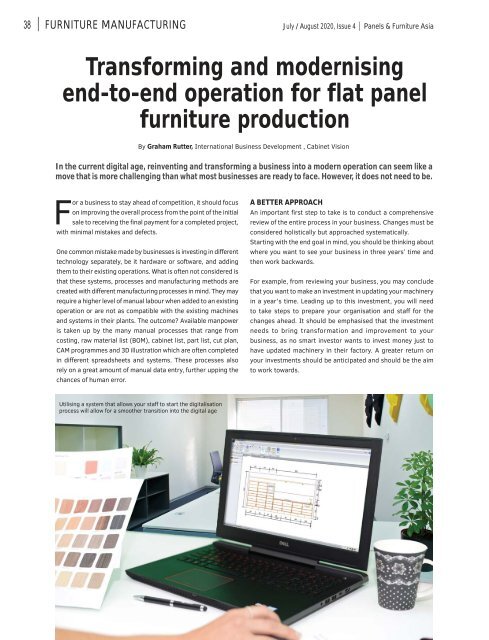Panels & Furniture Asia July/August 2020
Panels & Furniture Asia (PFA) is a leading regional trade magazine dedicated to the woodbased panel, furniture and flooring processing industry. Published bi-monthly since 2000, PFA delivers authentic journalism to cover the latest news, technology, machinery, projects, products and trade events throughout the sector. With a hardcopy and digital readership comprising manufacturers, designers and specifiers, among others, PFA is the platform of choice for connecting brands across the global woodworking landscape.
Panels & Furniture Asia (PFA) is a leading regional trade magazine dedicated to the woodbased panel, furniture and flooring processing industry. Published bi-monthly since 2000, PFA delivers authentic journalism to cover the latest news, technology, machinery, projects, products and trade events throughout the sector. With a hardcopy and digital readership comprising manufacturers, designers and specifiers, among others, PFA is the platform of choice for connecting brands across the global woodworking landscape.
- No tags were found...
Create successful ePaper yourself
Turn your PDF publications into a flip-book with our unique Google optimized e-Paper software.
38 | FURNITURE MANUFACTURING<br />
<strong>July</strong> / <strong>August</strong> <strong>2020</strong>, Issue 4 | <strong>Panels</strong> & <strong>Furniture</strong> <strong>Asia</strong><br />
Transforming and modernising<br />
end-to-end operation for flat panel<br />
furniture production<br />
By Graham Rutter, International Business Development , Cabinet Vision<br />
In the current digital age, reinventing and transforming a business into a modern operation can seem like a<br />
move that is more challenging than what most businesses are ready to face. However, it does not need to be.<br />
For a business to stay ahead of competition, it should focus<br />
on improving the overall process from the point of the initial<br />
sale to receiving the final payment for a completed project,<br />
with minimal mistakes and defects.<br />
One common mistake made by businesses is investing in different<br />
technology separately, be it hardware or software, and adding<br />
them to their existing operations. What is often not considered is<br />
that these systems, processes and manufacturing methods are<br />
created with different manufacturing processes in mind. They may<br />
require a higher level of manual labour when added to an existing<br />
operation or are not as compatible with the existing machines<br />
and systems in their plants. The outcome? Available manpower<br />
is taken up by the many manual processes that range from<br />
costing, raw material list (BOM), cabinet list, part list, cut plan,<br />
CAM programmes and 3D illustration which are often completed<br />
in different spreadsheets and systems. These processes also<br />
rely on a great amount of manual data entry, further upping the<br />
chances of human error.<br />
A BETTER APPROACH<br />
An important first step to take is to conduct a comprehensive<br />
review of the entire process in your business. Changes must be<br />
considered holistically but approached systematically.<br />
Starting with the end goal in mind, you should be thinking about<br />
where you want to see your business in three years’ time and<br />
then work backwards.<br />
For example, from reviewing your business, you may conclude<br />
that you want to make an investment in updating your machinery<br />
in a year’s time. Leading up to this investment, you will need<br />
to take steps to prepare your organisation and staff for the<br />
changes ahead. It should be emphasised that the investment<br />
needs to bring transformation and improvement to your<br />
business, as no smart investor wants to invest money just to<br />
have updated machinery in their factory. A greater return on<br />
your investments should be anticipated and should be the aim<br />
to work towards.<br />
Utilising a system that allows your staff to start the digitalisation<br />
process will allow for a smoother transition into the digital age


















